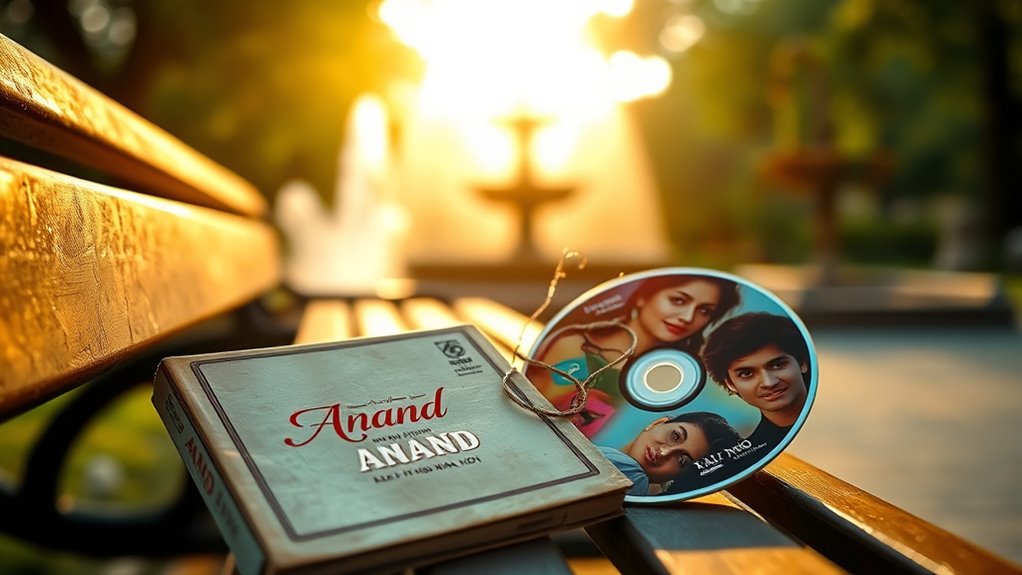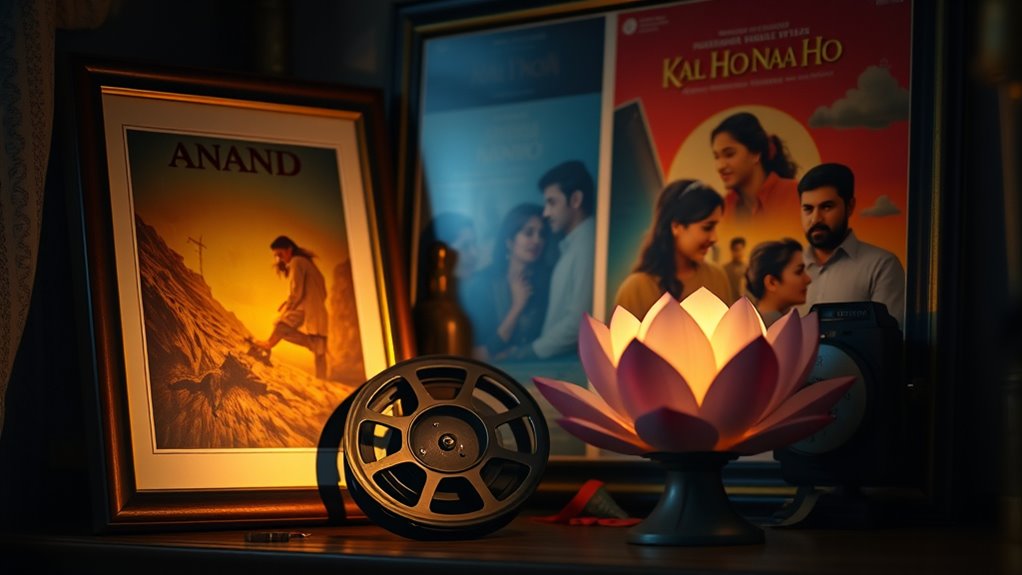Many fans see “Kal Ho Naa Ho” as a spiritual successor to “Anand” because both films explore deep themes of life, death, and living in the moment. They highlight the importance of love, hope, and embracing life despite hardships, reflecting timeless cultural values. Both movies inspire viewers to focus on what truly matters and cherish every day. If you want to uncover more connections, keep exploring how these stories resonate across generations.
Key Takeaways
- Both films explore themes of life, death, and living fully, emphasizing cherishing each moment regardless of mortality.
- They share a philosophical outlook that love, hope, and positivity give life deep meaning.
- Cultural values of emotional resilience, relationships, and spiritual acceptance connect the movies beyond mere storytelling.
- “Anand” and “Kal Ho Naa Ho” highlight human connection as central to life’s purpose, fostering a sense of continuity.
- The films collectively promote authentic living and embracing life’s uncertainties, suggesting a spiritual link across generations.

Many fans believe that “Kal Ho Naa Ho” serves as a spiritual sequel to “Anand,” suggesting a deeper connection between the two films beyond their distinct stories. This theory hinges on the idea that both movies explore universal themes of life, death, and the importance of living fully in the present. When you examine the films closely, you’ll notice they share more than just emotional resonance—they reflect profound cultural connections and thematic parallels that tie them together in a meaningful way.
Many believe Kal Ho Naa Ho is a spiritual sequel to Anand, sharing themes of life, death, and living fully.
In “Anand,” you see a story centered on a joyful, spirited man who faces his terminal illness with an unshakeable zest for life. It’s about embracing every moment despite the inevitability of death. Similarly, “Kal Ho Naa Ho” introduces you to characters *confronting* love, loss, and hope in a contemporary setting. The film’s central message encourages you to cherish today because tomorrow isn’t guaranteed. The characters’ journeys mirror each other’s in their pursuit of happiness amid adversity, emphasizing a common philosophical outlook — that life’s true value lies in the moments you seize.
Cultural connections play a *crucial* role in how these films communicate their themes. Both movies draw heavily from Indian cultural values, highlighting the importance of relationships, emotional resilience, and spiritual acceptance. You’ll notice that the characters’ struggles are framed within a cultural context that respects tradition but also encourages personal growth and emotional openness. This shared cultural backdrop creates a bridge, allowing viewers to connect deeply with the stories, regardless of when they’re set.
The thematic parallels run deeper than surface-level storytelling. Both films explore the idea that love and human connection give life its meaning. In “Anand,” you see a man who chooses to bring happiness to everyone around him, even as he faces his own mortality. “Kal Ho Naa Ho” echoes this sentiment, emphasizing that living with love and hope can transcend pain and loss. The films challenge you to reflect on what truly matters — not material success but the emotional bonds you forge and the positivity you spread.
Ultimately, if you look beyond the plotlines, you’ll find that “Kal Ho Naa Ho” and “Anand” are linked through their shared philosophy. They encourage you to live authentically, love fiercely, and face the uncertainties of life with courage and optimism. The cultural connections and thematic parallels aren’t mere coincidences—they serve as a *testament* to the timeless, universal messages that both films convey. In doing so, they invite you to see life as a precious gift, worth celebrating every day.
Frequently Asked Questions
How Do the Themes of Hope Compare in Both Films?
You notice that both films explore hopefulness amid despair, emphasizing how characters confront existentialism. In “Kal Ho Naa Ho,” hope is portrayed as a crucial force that helps characters find joy despite life’s uncertainties. Similarly, “Anand” highlights hope as a way to transcend suffering and embrace life’s fleeting beauty. Both films inspire you to cling to hope, showing it as essential for steering through life’s challenges with resilience and optimism.
Are There Shared Characters or References Linking the Two Movies?
Did you know that only a few shared characters or recurring references link “Kal Ho Naa Ho” and “Anand”? You might notice glimpses of similar themes or subtle nods, but they don’t share main characters. Instead, the connection lies in recurring references to hope, life, and emotional resilience. These details create a spiritual link, inviting you to explore deeper meanings beyond just shared cast or explicit references.
What Cultural or Philosophical Ideas Connect “Kal Ho Naa Ho” and “Anand”?
You’ll see that both films explore deep philosophical parallels about life’s fleeting nature and the importance of cherishing each moment. Cultural symbolism, like hope and resilience, ties them together, emphasizing emotional strength amid adversity. “Kal Ho Naa Ho” and “Anand” encourage you to embrace positivity and love, highlighting universal truths that transcend time and culture, making their messages resonate across generations through shared ideals of joy and acceptance.
Has the Director Ever Commented on This Fan Theory?
You might wonder if the director has addressed this fan speculation. While some fans hope for a clear link, the director hasn’t officially commented on whether “Kal Ho Naa Ho” is a spiritual sequel to “Anand.” Instead, he prefers to keep interpretations open, letting viewers explore the themes themselves. So, in this case, the director’s commentary remains silent, fueling fans’ imagination and ongoing discussions.
Do the Movies’ Endings Suggest a Spiritual or Philosophical Continuation?
You notice that the endings of both movies hint at themes of destiny and philosophical reflections on life. In “Kal Ho Naa Ho,” characters grapple with accepting life’s uncertainties, echoing “Anand”’s focus on finding joy despite suffering. Their character arcs show a spiritual continuation, suggesting that both films explore life’s deeper meanings. So, yes, their endings imply a philosophical and emotional link that hints at a spiritual sequel.
Conclusion
In the end, imagining “Kal Ho Naa Ho” as a spiritual sequel to “Anand” is like connecting stars in the night sky—each shining with hope and emotion. It’s a theory that links the themes of love, life, and acceptance across generations. While it’s not officially confirmed, it sparks your imagination and deepens your appreciation for both films. Sometimes, the most beautiful stories are the ones our hearts create, like a constellation guiding us through life’s journey.









